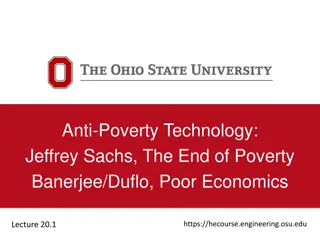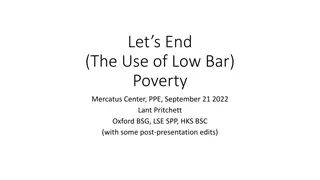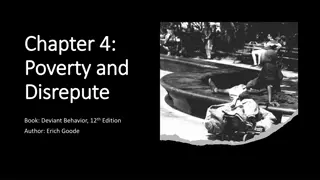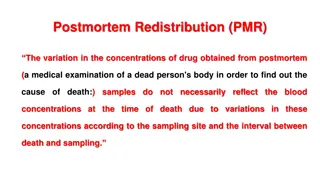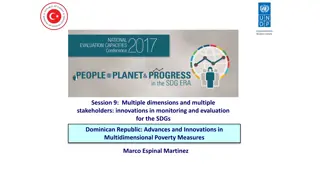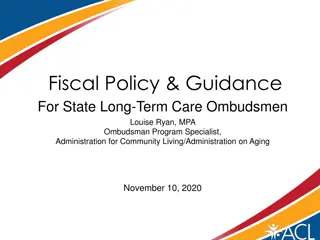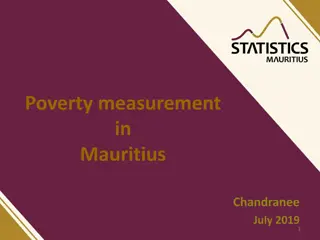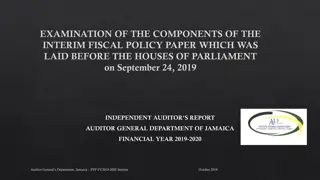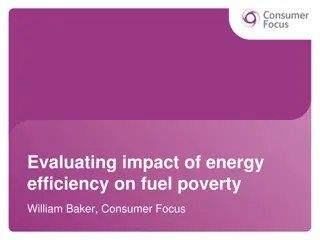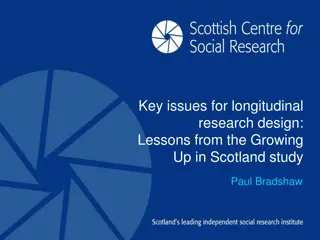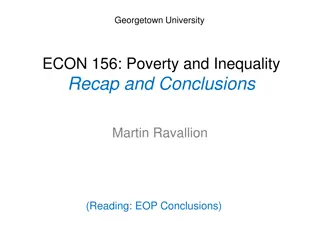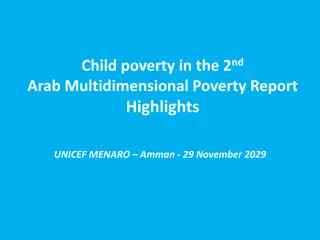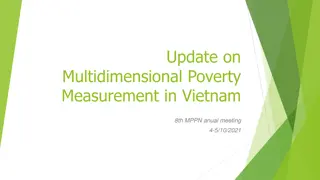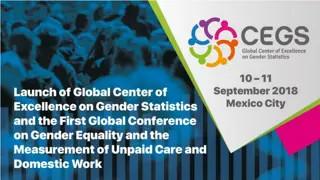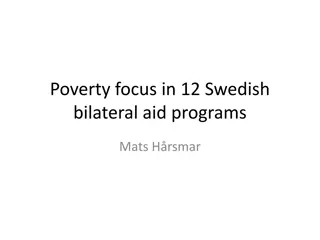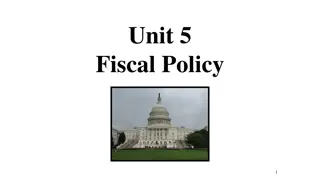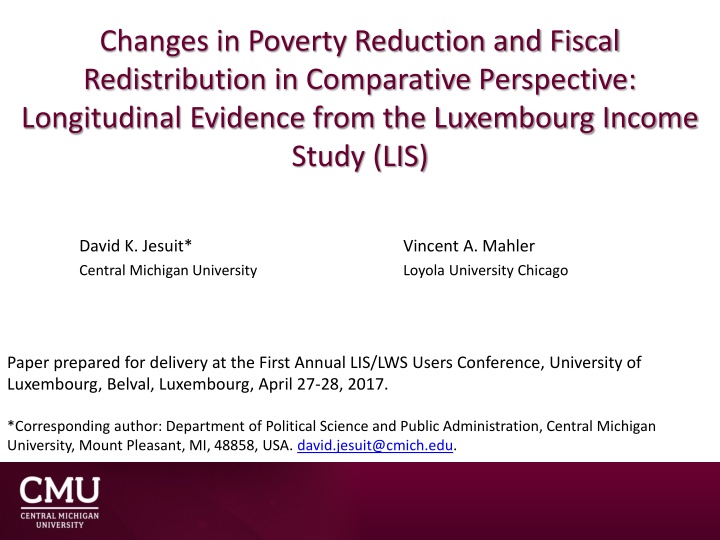
Changes in Poverty Reduction and Fiscal Redistribution: Longitudinal Evidence from Luxembourg Study
This paper presents longitudinal evidence on poverty reduction and fiscal redistribution from the Luxembourg Income Study (LIS), analyzing changes over time in poverty, affluence, and the middle class across multiple countries. It explores the trade-off between poverty reduction and impacts on the affluent, focusing on modes of redistribution such as social transfers and pensions.
Download Presentation

Please find below an Image/Link to download the presentation.
The content on the website is provided AS IS for your information and personal use only. It may not be sold, licensed, or shared on other websites without obtaining consent from the author. If you encounter any issues during the download, it is possible that the publisher has removed the file from their server.
You are allowed to download the files provided on this website for personal or commercial use, subject to the condition that they are used lawfully. All files are the property of their respective owners.
The content on the website is provided AS IS for your information and personal use only. It may not be sold, licensed, or shared on other websites without obtaining consent from the author.
E N D
Presentation Transcript
Changes in Poverty Reduction and Fiscal Redistribution in Comparative Perspective: Longitudinal Evidence from the Luxembourg Income Study (LIS) David K. Jesuit* Central Michigan University Vincent A. Mahler Loyola University Chicago Paper prepared for delivery at the First Annual LIS/LWS Users Conference, University of Luxembourg, Belval, Luxembourg, April 27-28, 2017. *Corresponding author: Department of Political Science and Public Administration, Central Michigan University, Mount Pleasant, MI, 48858, USA. david.jesuit@cmich.edu.
Outline Update to Fiscal Redistribution Dataset (descriptive) Cross-national comparisons Poverty Affluence Middle class Changes over time 5 countries available for Wave II-IX (3 for I-IX) Is there a trade-off so that reductions in poverty come at the expense of the affluent?
Fiscal redistribution overview Modes of redistribution Social transfers (hits) Pensions (pensions) Working-aged (hits-pensions) Direct taxes: personal income taxes & social insurance contributions Second order effects Redistribution affects pre-government income Focus on pensions
Fiscal redistribution overview Poverty Poverty line=50% median post-government equivalent income Example: family of four in the US in 2013 poverty line=$31,955 (50% of the median income multiplied by the square root of four, or two) Affluence Affluence line=200% median disposable income Example: affluence threshold of $63,010 per equivalent adult or $126,020 for a family of four in US in 2013. Middle class=share neither affluent or poor
Fiscal redistribution overview Redistribution Head count (pre-government income) - Head count (post-government income) Absolute v. relative reductions Trends 1980 (LIS Wave II)-2014 (LIS Wave IX) Means by LIS Wave computed for five countries: Germany Netherlands Norway UK US Conclusions
Table 1. Poverty rates and poverty reduction by income source: averages by country. Private Disposable Abs. Red. Poverty Pct. Red. Poverty Transfers Taxes Inc. Poverty Country1 Pensions Work-age Czech Rep. Finland Netherlands Denmark Belgium Sweden Slovak Rep. Poland Germany Luxembourg Norway Austria Ireland Iceland UK Greece Italy Switzerland Estonia Spain Australia Canada Japan USA MEAN 1Countries listed in descending order of percent reduction in poverty headcount ratio Note: Poverty rate is the percent population whose equalized income falls below 50 percent of their country s median. 27.4 29.7 28.3 28.6 29.4 28.9 27.3 36.9 27.8 29.3 25.5 30.3 35.9 17.7 31.0 33.2 30.0 20.0 30.7 33.6 26.4 26.3 19.5 26.8 28.4 5.0 6.1 5.8 6.5 6.6 6.8 6.6 9.8 7.3 7.9 6.9 8.6 11.3 5.8 10.5 13.2 12.3 8.5 13.3 14.8 12.5 12.6 10.9 16.8 9.4 22.3 23.6 22.4 22.2 22.8 22.1 20.7 27.1 20.4 21.4 18.6 21.7 24.6 11.9 20.5 20.1 17.7 11.5 17.4 18.8 13.9 13.7 8.6 10.0 18.9 81.4% 79.5% 79.2% 77.6% 77.6% 76.5% 75.8% 73.4% 73.4% 73.0% 72.9% 71.6% 68.5% 67.2% 66.1% 60.5% 59.0% 57.5% 56.7% 56.0% 52.7% 52.1% 44.1% 37.3% 66.2% 23.0 25.4 24.6 25.4 23.6 24.2 21.8 28.2 21.9 24.4 20.0 23.6 25.2 13.8 22.4 24.1 20.3 16.5 19.0 20.9 14.4 14.7 11.1 11.9 20.9 -0.7 -1.8 -2.2 -3.2 -0.8 -2.1 -1.1 -1.1 -1.5 -2.9 -1.4 -1.9 -0.5 -1.9 -1.9 -4.0 -2.6 -5.0 -1.6 -2.1 -0.5 -1.0 -2.5 -1.9 -1.9 18.7 17.0 18.2 17.6 16.9 16.0 17.1 23.6 17.2 17.4 12.5 17.7 9.5 10.7 11.3 22.5 19.6 14.6 15.9 16.4 8.3 9.1 10.3 8.8 15.3 4.4 8.4 6.4 7.8 6.8 8.2 4.7 4.6 4.7 6.9 7.5 5.9 15.7 3.1 11.0 1.6 0.7 1.9 3.2 4.5 6.2 5.6 0.8 3.2 5.6 0.3 0.2 0.5 0.5 0.3 0.9 0.5 0.3 0.6 0.8 0.5 0.7 0.1 0.6 0.6 2.9 2.1 2.2 0.7 1.5 0.1 0.3 1.3 0.8 0.8
Conclusions: poverty comparisons Substantial variation in levels of pre- and post- government income poverty This is also true for the countries in central and Eastern Europe that we recently added. Reductions in poverty are accomplished solely through transfers. Pensions make up the vast majority of transfer income in nearly every country we examine. Direct taxes, when examined separately, tend to increase poverty.
Conclusions: affluence & middle-class Rates of affluence vary widely, with largest shares in Estonia and the US and smallest in Nordic countries. Taxes have the largest redistributive effect, reducing the size of the affluent population by about 75% Transfers move people into affluence, though in much smaller numbers Pre-taxes and -transfers, UK had smallest middle class & Denmark the largest. After taxes and transfers, Sweden had largest middle class.
Conclusions: changes in poverty & middle class over time Private income poverty has grown steadily since 1980 Most of these increases have been offset by transfer income, especially income from old-age pensions The effect of pensions in reducing poverty nearly doubled since 1980 The effect of working-age transfer income on poverty fluctuated, seeming to coincide with the rise and fall of the economic cycle Though small, the effect of taxes varied somewhat as well Middle class has been shrinking, though by smaller amount after transfers added
Conclusions: change in affluence over time Post-government affluence grew in the last 3 decades The steady increase in the percent affluent was due to taxes, which have become less redistributive in the last 3 decades Working against this trend was the steady increase in transfer income generosity, moving more people into affluence over time Once again, this is especially true for pension income At top of income distribution taxes play a much larger role than transfers; for every person made affluent from transfers, two are moved out by taxes Private sector affluence also grew, but it was not steady and peaked in 1995 before falling and then rising again
Table 3. Regression analysis of poverty and poverty reduction by income component Poverty rate Net poverty reduction Reduction in poverty via taxes Net not Rich Not rich taxes Not rich transfers constant -0.301* 0.135 -0.035 0.266 -0.101* 0.039 -0.273* 0.126 0.230 0.232 -0.107** 0.026 0.490 0.413 -1.957** 0.480 0.284** 0.093 -0.893 0.453 0.124 11.877** 12.572** 11.048** 19.097** 16.102** 12.105** -1.028** 1.547 2.000 1.897 2.537 0.087 0.102 0.043 0.001 -0.611 0.306 0.134 3.359 0.029 2.263 0.269 0.298 0.083 R sq. Transfer reduction Pension reduction Working-age transfer reduction Net not Rich Not rich taxes Not rich transfers constant 0.065 0.275 -0.112 0.274 0.177** 0.065 0.337 0.234 0.158 0.230 0.179** 0.047 -2.241** 0.477 -1.811** 0.428 -0.431 0.289 20.125** 16.713** 12.997** 15.604** 12.819** 8.474** 4.521** 3.895** 4.523** 2.601 3.392 2.166 2.575 3.286 0.002 0.061 0.350 0.006 0.018 2.047 0.312 0.909 0.028 0.947 0.041 1.173 0.031 R sq. n=154 ** p<0.01, * p<0.05, two-tailed test. Top number is the estimate; bottom number is the robust standard error, adjusting for 24 clusters.
Conclusions: Robin Hood Effect Reductions in poverty came at the expense of the affluent Lower poverty rates are associated with larger net reductions and reductions via taxes of the share considered affluent Reductions were associated with larger reductions from working-aged transfer income, but not pensions Transfer income generosity associated with larger net reduction in poverty overall, both via all transfers, and via pensions Coefficient suggests that for every one person becoming affluent, two people move out of poverty. In other words, transfers disproportionately favor the poor.


